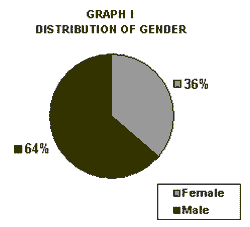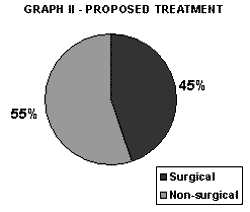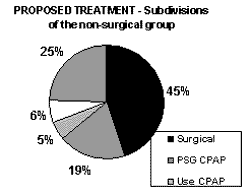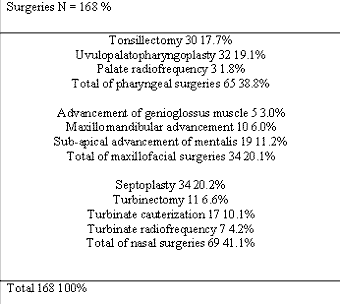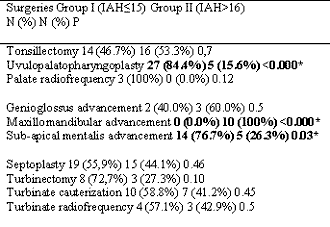

Year: 2004 Vol. 70 Ed. 1 - (7º)
Artigo Original
Pages: 46 to 51
Otolaryngological surgery indication in a clinic for patients with obstructive sleep apnea-hypopnea syndrome
Author(s):
Fernanda Louise Martinho 1,
Adriane I. Zonato 2,
Lia Rita A Bittencourt 3,
Carla L Gregório 4,
Luiz Carlos Gregório 5,
Sérgio Tufik 6
Keywords: apnea, surgery, obstructive sleep apnea-hipopnea syndrome
Abstract:
Aim: Otolaryngology surgical procedure is an option for obstructive sleep apnea-hypopnea syndrome (OSAHS) treatment. The objective of this study is to show which procedures can be done well as their indications. Study Design: Clinical retrospective. Method: 223 patients with OSAHS were studied in Otolaryngology Department of UNIFESP. Every patient had a previous polissonography, and they were analyzed and treatment options were proposed. The treatment options were divided in no surgical (CPAP, dental appliance and general measures) and surgical procedures (pharynx surgery, rhinosurgery and maxillofacial surgery). Result: 100 patients (44,8%) had surgery indication, and 168 procedures were proposed. The majority uvulopalatopharyngoplasty and radiofrequency of the soft palate were indicated in mild and moderate OSAHS cases and maxillomandibular surgery were indicated in severe cases. Tonsillectomy and rhinosurgery were indicated independently of OSAHS severity. Conclusion: The otolaryngological surgery is an option in OSAHS treatment, and your indication depends on OSAHS severity. The surgical procedure can be done whit curative intetion or to avoid CPAP use.
![]()
INTRODUCTION
Obstructive sleep apnea-hypoapnea syndrome (OSAHS) has high population prevalence, affecting 4% of men and 2% of women when considering the presence of excessive daily drowsiness and apnea-hypoapnea index (IAH) higher than five per hour of sleep in the polysomnography (PSG)1.
It is known that patients have higher risk of cardiovascular diseases, especially with arterial blood hypertension, which can be present in 30% of the cases 2. Moreover, the presence of excessive daily drowsiness, a frequent complaint reported by these patients, increases the risk of traffic and work-related accidents confirming the morbidity and mortality of the disease. For these reasons, recurrent OSAHS is considered a public health problem 3.
Different theories have been proposed to explain the pathophysiology of the disease which is multifactorial, probably as a result of the anatomical affections associated with the neuromuscular abnormalities placed in the pharynx 4.Therefore, obesity and anatomical alterations of the upper airways and facial skeleton have been related with the disease pathophysiology 5.
The diagnosis is made by clinical examination and polysomnography. In 1999, AASM - American Academy of Sleep Medicine proposed the creation of a task force, from which derived diagnostic and severity criteria of the disease. Therefore, the presence of daily symptoms such as excessive daily drowsiness, cognitive affections (memory and concentration deficit), among others, associated with the index of apnea-hypoapnea per hour of sleep (IAH) obtained in the polysomnography allowed us to define severity of the disease 6.
In this task force, IAH was defined as being normal when below 5, mildly increased between 5 and 15, moderate between 15 and 30 and severe when greater than 30 6.
Treatment of OSAHS is mandatory and CPAP (continuous positive airway pressure) has been selected as the first option, but it is difficult to adapt it and other therapeutic measures are normally suggested. Thus, the treatment of OSAHS can be performed using different methods depending on severity of the disease and upper airways and facial skeleton anatomical deficiencies found in patients 7.
Different surgical treatments have been proposed and they can both involve correction of anatomical abnormalities found in the pharynx 8-12, nasal cavity 13 and tongue base 3, 14, 15, as well as correction of cranial-facial skeleton 14-17. Results published by the literature are controversial and normally indication to surgical procedures is related with severity of OSAHS and the affections found in the upper airways and facial skeleton 8, 13, 18. Moreover, surgical treatment can be curative or adjuvant to other therapies, benefiting patients with OSAHS when it is well indicated 19.
Treatment of OSAHS should be multidisciplinary and conducted through different modalities: nasal CPAP, intraoral appliances, general measures and ENT surgical treatment.
This study aims at assessing and discussing the way surgical indications were made to patients with obstructive sleep breathing problems in the outpatient unit of otorhinolaryngology at Federal University of Sao Paulo (UNIFESP). The data presented refer to surgical indication only and not to postoperative results.
MATERIAL AND METHOD
We conducted a retrospective study with 223 patients that were seen in the outpatient unit of otorhinolaryngology, UNIFESP, directed to patients with sleep breathing problems, in the period between March and December 2001. All the cases were assessed under the supervision of the attending physicians at the outpatient unit (L.C.G.; A.I.Z.).
All patients had been submitted to baseline polysomnography and also clinical history and ENT physical examination before therapeutic assessment.
ENT physical examination was conducted with facial inspection in which we tried to assess suggestive signs of retrognathism and maxilla hypoplasia; anterior rhinoscopy and oroscopy, in which we assessed the oral cavity and oropharynx, dental occlusion and Mallampati index.
In our center, surgical indication is based on the presence of anatomical affections of upper airways and facial skeleton and disease severity, based on clinical and polysomnography findings. Thus, patients were individually analyzed and therapeutic measures were proposed.
Therapeutic indication was divided into ENT surgical and non-surgical types. Non-surgical indications were the following: general measures (control of obesity and associated disease, including clinical treatment of rhinopathies), use of CPAP and use of intra-oral appliances.
ENT surgical indication was categorized as pharyngeal procedures (tonsillectomy, uvulopalatopharyngoplasty and palate radiofrequency), maxillofacial (sub-apical mentalis advancement, genioglossus advancement, and maxillomandibular advancement) and nasal (septoplasty, turbinectomy, cauterization of inferior turbinate and turbinate radiofrequency).
After collection of data relative to the indicated treatment, patients were divided into two groups. In group I, we placed non-apneic snoring patients and those with mild OSAHS, that is, those with IAH ? 15/h; in group II, we included those who had moderate or severe OSAHS, that is, those who had IAH > 15/h. To compare the groups, we used x2 test.
We decided to classify the patients as described above so as to assess whether the surgical indication made in our outpatient center was based on severity of the disease.
RESULTS
Out of 223 patients, 36.3% were female and 63.7% were male patients (Graph 1), aged on average 48 years +/- 12.7 (ranging from 14 to 75 years) and mean of body mass index of 29 +/- 5 Kg/m2.
As to polysomnography, 18.4% presented IAH within the normal range (IAH ? 15/h - non-apneic snoring patients), 30.7% had mild OSAHS and 16.6% had moderate OSAHS, whereas 27.4% had severe OSAHS (Table 1).
Among assessed patients, 44.8% (100 patients) had indication for ENT surgical procedure and 55.2% received another type of indication: order of polysomnography to define titration of pressure for CPAP use (24.2%), use of intraoral appliances (6.3%) and general measures (24.7%) (Graph II).
For 100 patients (45%) with surgical indication, a total of 168 procedures were proposed. Thus, some patients were indicated to perform more than one surgical procedure.
The indicated surgeries were: tonsillectomy (17.7%), uvulopalatopharyngoplasty (UVPF-19.1%), sub-apical mentalis advancement (11.2%), genioglossus advancement (3.0%), maxillomandibular advancement (6.0%), septoplasty (20.2%), inferior turbinectomy (6.6%), inferior turbinate cauterization (10.1%), palate radiofrequency (1.8%) and inferior turbinate radiofrequency (4.2%) (Table 2).
As to severity of the disease, surgeries were analyzed separately into two groups: group I (patients that snored and had mild OSAHS) and group II (patients that snored and had moderate and severe OSAHS). Therefore, indication of uvulopalatopharyngoplasty and sub-apical mentalis advancement was statistically more frequent in patients in group I (84.4% and 76.7%, respectively), and maxillomandibular advancement was detected only in patients in group II (100%). Palate radiofrequency was indicated only in patients with mild clinical picture, but statistically it was not significant since there were very few indications. The indication of tonsillectomy and nasal surgeries did not vary according to disease severity (Table 3).
All patients in group II that received indication of uvulopalatopharyngoplasty or genioglossus advancement presented IAH ? 30/h, that is, these procedures were not indicated in any of the severe cases.
DISCUSSION
Owing to high prevalence 1 and associated co-morbidities 2, 3 treatment of OSAHS is mandatory and it can be performed with different modalities, since pathophysiology of the disease is multifactorial 4, 5.
Surgical ENT procedures represent a form of treatment for patients with OSAHS and according to a symposium published by the Brazilian Society of Otorhinolaryngology referring to the use of ENT surgical approaches in apnea and sleep surgeries, indications are based on severity of disease and presence of anatomical upper airway and facial skeleton abnormalities 7, 18. Patients were divided into two groups, concerning disease severity, according to what was proposed by the American Academy of Sleep Medicine 6.
ENT surgical treatment was cautiously indicated in approximately half (44.8%) of the patients included in this study, prioritizing severity of the disease and ENT physical examination. In our center, surgical treatment represents a therapeutic option and it is not the treatment of choice in all patients.
Pharyngeal and nasal cavity surgeries are indicated for curative purposes in mild cases (snoring and mild OSAHS) and as adjuvant in more severe cases (moderate and severe OSAHS), in which the main treatment was nasal CPAP.
Candidates for the use of CPAP that present complaints of nasal obstruction, be it by nasal mucosa inflammatory disease or structural affections (septal deviation, nasal concha hypertrophy or nasal valve collapse) can require surgical treatment before the use of CPAP. In these cases, regardless of the breathing disorder, nasal surgery is beneficial. Similarly, patients with significant tonsil hypertrophy can present difficulties in using CPAP, especially related with high pressure levels. Tonsillectomy, in these cases, can be beneficial for sealing oropharynx and reducing upper airway resistance, allowing the use of CPAP with lower and more tolerable pressure levels 19.
Despite limited results in nasal surgery in cure of OSAHS, benefits in sleep quality are frequently observed. Verse et al. 13 advocated the conduction of nasal surgery regardless of severity of OSAHS, since sealing of the nasal cavity leads to reduction in sleep fragmentation, with improvement in sleep quality and daily drowsiness.
According to the scientific literature, uvulopalatopharyngoplasty presents better results in mild cases 8, 9. Lauretano 10 reported snoring reduction in 83% of the patients submitted to uvulopalatopharyngoplasty that presented primary snoring and in 71% of those that presented mild OSAHS, which were 30% and 44%, respectively. Troell et al.11 and Blumen et al.12 advocated the use of soft palate radiofrequency for patients with primary snoring and mild to moderate OSAHS, and referred that patients with snoring or mild OSAHS are highly likely to be cured by applying this procedure.
In our study, most of the indications of uvulopalatopharyngoplasty and palate radiofrequency were in patients with snoring and mild OSAHS. Patients in group II that presented indication of uvulopalatopharyngoplasty presented IAH inferior to 30, which was not indicated in severe patients.
We believe that patients that had previously undergone tonsillectomy, presented limited results when submitted to uvulopalatopharyngoplasty, therefore, we preferred not to indicate this procedure to these patients. Thus, patients in the group I and II that had redundant or posterior palate that had been submitted to tonsillectomy, were referred to radiofrequency instead.
It is important to point out that uvulopalatopharyngoplasty conducted in our service is a conservative procedure, removing as little soft palate as possible (only at the uvula attachment level), trying to prevent complications resultant from this procedure.
According to Riley et al.14, genioglossus advancement surgery with myotomy and hyoid elevation (Stanford Phase I) is successful (reduction of 50% IAH) in 61% of the patients and maxillomandibular advancement (Stanford Phase II) presented as much as 97% success rates. Maxillomandibular advancement can be indicated as initial form of treatment for severe OSAHS 16 and patients do not necessarily need to have a facial skeleton affection to benefit from the procedure.
The main indications of maxillomandibular advancement are reserved for treatment of patients with severe OSAHS that do not get adapted to CPAP or as a salvage surgery to other unsuccessful procedures. Conversely, young patients with mild to moderate OSAHS with evident maxillomandibular dimorphism can have maxillomandibular advancement as the main and initial therapeutic modality 17.
Sub-apical mentalis advancement was indicated in patients that presented OSAHS associated with retrognathism or micrognathism in an attempt to improve OSAHS by advancing the genioglossus muscle and correcting the esthetical alteration of the face by mentalis advancement 15.
Tonsillectomy and nasal surgery were indicated regardless of IAH level. In milder cases (primary snoring and mild OSAHS), the intention was curative and in moderate to severe cases the intention was to reduce the resistance of the upper airways and to improve the adaptation of CPAP, as previously referred.
In addition to IAH, upon indicating a surgical procedure we should consider co-morbidities presented by patients, such as obesity and associated diseases (hypertension, diabetes mellitus and arrhythmia) since we know that these factors increase the surgical risk for these patients.
Obesity presents a relevant role in pathophysiology of OSAHS, and it should always be treated; however, the treatment is complex and not always possible. For this reason, we can not wait for the patient to control his/her weight and then start treatment for OSAHS.
Since it is a multifactorial disease, the assessment of patients with OSAHS should be multidisciplinary, careful and conservative, and otorhinolaryngologists play a key role in optimizing treatment, be it curative and surgical or adjuvant to other kinds of treatment.
CONCLUSION
1. ENT surgical indication for OSAHS should be careful and it is not the only modality of treatment;
2. Surgical indication should be based on severity of the disease and presence of anatomical affections of upper airways and craniofacial skeleton.
3. The purpose of ENT surgical treatment can be curative or adjuvant to other therapies.
Table 1
DISTRIBUTION OF SEVERITY OF OSAHS
Table 2.
INDICATED SURGERIES
N: number of surgical procedures
Table 3
DISTRIBUTION OF SURGICAL PROCEDURES CONCERNING SEVERITY OF OSAHS
* Statistically significant values (P<0.05)
N: number of surgical procedures
REFERENCES
1. Young T, Palta M, Dempsey J, et al. The occurrence of sleep-disordered breathing middle-aged adults. N Engl J Med 1993; 328:1230-5.
2. Schmid-Nowara WW, Coultas D, Wiggins C, et al. Snoring in Hispanic-American population: risk factors and association whit hypertension and others morbidity. Arch Intern Med 1990; 150:597.
3. Phillipson EA. Sleep apnea - a major public health problem (editorial). N Engl J Med 1993; 328:1271-73.
4. Badr MS. Pathophysiology of upper airway obstruction during sleep. Clin In Chest Med 1998; 19(1):21-32.
5. Kuna S, Remmers JE. Anatomy and Physiology of Upper Airway Obstruction. In Krieger MH, Roth T, Dement WC (eds.). Principles and Practice of Sleep Medicine. 3rd ed. Philadelphia: WB Saunders. p. 840-58.
6. Sleep-Related Breathing Disorders in Adults: Recommendations for Syndrome Definition and Measurement Techniques in Clinical Research - AASM Task Force. Sleep 1999; 22(5) 667-89.
7. Atualização Otorrinolaringológica em Cirurgia do Ronco e Apnéia. Revista Brasileira de Otorrinolaringologia set/out 2002; 68(5) supl. 3.
8. Vilaseca I, Morello A, Montserrat JM, et al. Usefulness of uvulopalatopharyngoplasty with genioglossus and hyoid advancement in the treatment of obstructive sleep apnea. Arch Otolaryngol Head and Neck Surg 2002; 128(4):435-40.
9. Sher AE, Schechtman KB, Piccirillo JF. The efficacy of surgical modifications of the upper airway in adults with obstructive sleep apnea syndrome. Sleep 1996; 19(2):156-177.
10. Lauretano AM. Uvulopalatoplasty using laser-assisted techniques. Operative techniques in otolaryngology - Head and Neck surgery mar 2000; 11(1): 7-11.
11. Troell RJ, Li KK, Powell NB, Riley RW. Radiofrequency of the soft palate in snoring and sleep-disordered breathing. Operative techniques in otolaryngology. Head and Neck surgery mar 2000; 11(1): 21-3.
12. Blumen MB, Dahan S, Fleury B, et al. Radiofrequency ablation for the treatment of mild to moderate obstructive sleep apnea. Laryngoscope nov 2002; 112(11):2086-92.
13. Verse T, Maurer JT, Pirsig W. Effect of nasal surgery on sleep-related breathing disorders. Laryngoscope 2002; 112(1):64-8.
14. Riley RW, Powell NB, Guilleminault C. Obstructive sleep apnea syndrome: a review of 306 consecutively surgical patients. Otolaryngol Head and Neck Surg. 1993 108(2):117-125.
15. Santos Junior J, Zonato AI, Martinho FL, Gregório LC, Miranda S. Mandibular anterior osteotomy with chin advancement for treatment of obstructive sleep apnea syndrome in patients with mandibular retrognathism: report a case. Revista Hypnos 2001, 2:29-33.
16. Prinsell JR. Maxillomandibular advancement surgery for obstructive sleep apnea syndrome. J Am Dent Assoc nov 2002; 133(11):1489-97.
17. Gooday RH, Percious DS, Morrison AD, et al. Obstructive sleep apnea syndrome: diagnosis and management. J Am Dent Assoc dec 2001; 67(11):652-8.
18. Goodday RH, Percious DS, Morrison AD, Robertson CG. Obstructive sleep apnea syndrome: diagnosis and management. J Can Dent Assoc 2001; 67(11):652-8.
19. Zonato AI, Bittencourt LR, Martinho FL, Gregório LC, Tufik S. Upper Airway Surgery to improve CPAP Titration Level in Patients With Obstructive. Sleep Apnea-Hypopnea Syndrome. In: 7TH World Congress on Sleep Apnea, Helsinki, Finland, 2003.
1 Post-graduation studies under course, Department of Otorhinolaryngology, UNIFESP.
2 Ph.D. in Medicine, FMUSP.
3 Professor, Ph.D., Department of Psychobiology, UNIFESP.
4 Undergraduate, Medical School, ABC.
5 Professor, Ph.D., Head of the Discipline of Otorhinolaryngology, UNIFESP.
6 Professor, Ph.D., Head of the Department of Psychobiology, UNIFESP.
Study conducted at the Discipline of Otorhinolaryngology and Sleep Institute, UNIFESP.
Address correspondence to: Fernanda Louise Martinho - Rua Sao Benedito 1335 Alto da Boa Vista 04735-003 Sao Paulo SP.
Fax (55 11) 5521-4666 - E-mail:femartinho@uol.com.br
Study presented at 36th Congresso Brasileiro de Otorrinolaringologia, Florianopolis, 2002.
